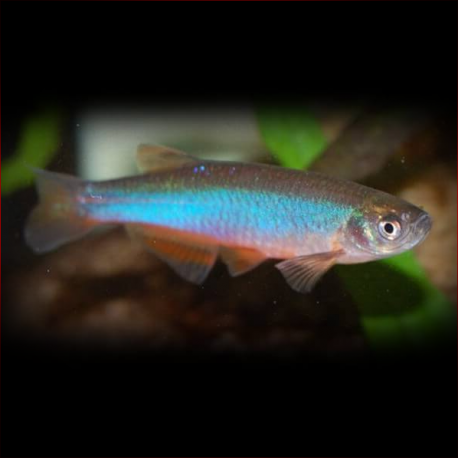More info
Datasheet
| Minimum Tank Size | 60 litres / 15.85 US gallons |
| Maximum Size | 3.0cm / 1.18inches |
| Temperature | 22°C / 71.60°F - 27°C / 80.60°F |
| Hardness | 1.01dgH / 18ppm - 5.04dgH / 90ppm |
| pH | 6.5-7.5 |
General Description
The Brachydanio Aesculapii, commonly known as Panther 'Danio,' is a peaceful species ideal for community aquariums. It is a schooling fish that thrives in groups of 8-10 individuals, displaying vibrant colors when in the company of its own kind. This species is often traded under various names, with distinguishing features including a snakeskin color pattern and specific body stripes.
Aquarium Setup
To create a suitable environment for the Panther 'Danio,' a well-planted aquarium resembling a natural stream or river is recommended. The tank should have a dark substrate, variably-sized rocks, and driftwood branches. Hardy aquatic plants like Microsorum, Bolbitis, or Anubias can be added for additional cover. It is crucial to ensure the tank is tightly covered, as these fish are known jumpers. Water conditions should ideally include a pH range of 6.5-7.5, a temperature of 22-27°C, and a water hardness of 18-90ppm (see table).
Behaviour
Panther 'Danios' are schooling by nature and prefer being in groups for security, resulting in reduced stress and enhanced coloration. When kept in adequate numbers, males will display their best colors as they vie for female attention. They are compatible with a variety of fish species but are best kept with other small cyprinids, tetras, livebearers, rainbowfishes, anabantoids, catfishes, and loaches. Proper research must be done to ensure compatibility and space consideration due to their adult size.
Feeding and Diet
In their natural habitat, Panther 'Danios' primarily prey on insects and larvae. In an aquarium, they are unfussy eaters and readily accept various foods. A balanced diet should include high-quality dried foods supplemented with live or frozen fare like bloodworms, Daphnia, and Artemia. Such a diet not only enhances their coloration but also ensures overall health.
Reproduction & Dimorphism
This species follows the egg-scattering spawning method without any parental care. To encourage breeding, a separate breeding tank with suitable conditions is recommended. Sexually mature females are distinguished by being slightly larger and rounder-bellied compared to males. During spawning, males intensify in coloration, while females become noticeably fuller with eggs. Fry can be raised on a diet of small live foods and proprietary fry food.
Habitat and Distribution
Endemic to the Rakhine Yoma/Arakan mountains in Myanmar, these fish are typically found in shallow streams with clear water and substrates of gravel, rocks, and leaf litter. They prefer slow-flowing waters with the presence of small pools. The region experiences seasonal changes, with water levels rising during the rainy season. Panther 'Danios' are part of the diverse fish fauna of Myanmar, with most populations being endemic to the country.

